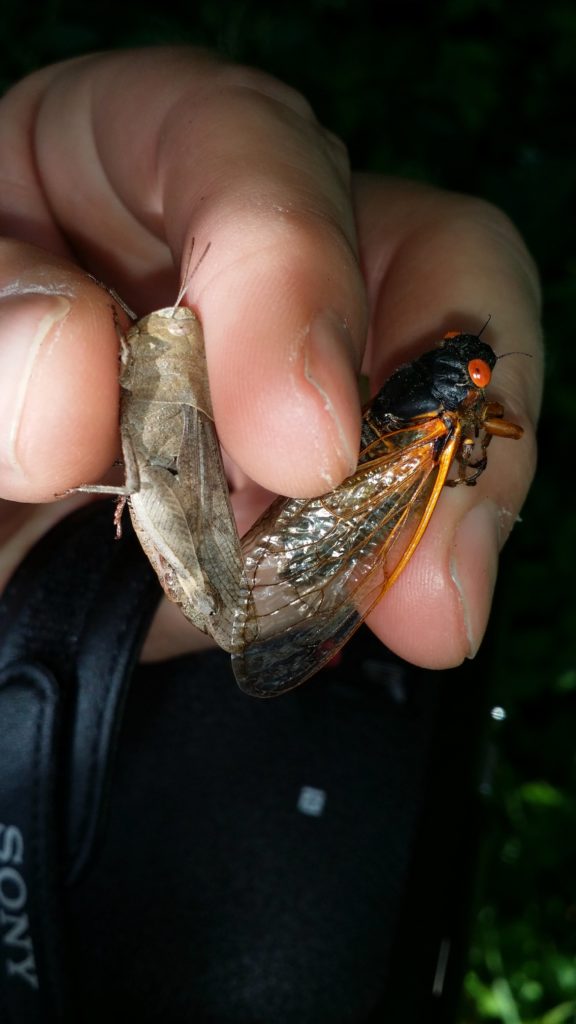There was an unexpected* emergence of periodical cicadas in Jim Thorpe, Pennsylvania this spring. Experts believe it is a disjunct brood related to Brood XIV. Brood XIV is found in the area, according to entomologist and Pennsylvania-based periodical cicada mapper Marten Edwards, but perhaps not in the exact same specific locations. Brood II is also in the area but on the other side of the mountain. Although this group of cicadas emerged the same year as Brood V, it probably is not related (genetically & evolutionary), but that is TBD.
The terrain of the Jim Thorpe area is comprised of mountains & valleys belonging to the Appalachian Mountain system of the Eastern United States. I observed cicadas on mountainsides and in lower valley areas. They seemed most plentiful and gregarious on the edges of the forest, preferring small, young maple trees where they gathered, sang, paired off, mated and died. Although their numbers were lesser deep in the woods, I did find exit holes and exuvia there. The most interesting discovery was finding a fully sclerotized, but dead, adult cicada within an overturned teacup left in the shade of an old tree. I discovered a few “cicada chimneys”, vertical structures made of soil surrounding exit holes, under pine trees where the cicadas seemed to need to extra hight to get above the thick layer of pine needles that littered the forest floor.
The best populations seemed to be along the Lehigh Gorge Trail from its entrance on Main Street to the Lehigh Gorge, and north, up the mountain the Lehigh Gorge Trail circumscribes, all the way to Lehigh Gorge Drive. The trees along Route 903, starting at Old Pipeline Road and heading south, were loaded with active cicadas — so many, that it was hard to avoid their flying bodies as I drove towards downtown Jim Thorpe.
If you want to see them, go this weekend (June 24-26). They were plentiful in the Lehigh Gorge area:
The population seems to be entirely made up of Magicicada septendecim. No Magicicada cassini or septendecula were found (so far).
A Carolina Grasshopper (Dissosteira carolina) next to a “Locust” (Magicicada septendecim).
More photos from this emergence in the gallery.
Locals were calling them “Locusts” — sometimes I forget that’s what folks call them, but of course they’re really cicadas.
Sound files: all are Magicicada septendecim
A single call:
A Spectrogram of its call:

Multiple males calling:
An extra-weird call around 11-12 seconds:
You can here some wing flicks in this one:
*Unexpected as cicada researchers were not expecting it, but locals probably knew about it.
Post script:
I found a scan of a news paper from 1880 (The Carbon advocate., March 06, 1880, Lehighton, Pa.) that mentions that “locusts” would emerge in the area in the summer. “Locust” is, of course, a common misnomer for cicada, the Carbon Advocate was the paper for the Mauch Chunk (Jim Thorpe) area, and 1880 was 8 x 17 years ago:

5 replies on “Jim Thorpe Pennsylvania Magicicada Emergence”
Nice post, thanks. It’s great to see these disjunct populations becoming recognized and added to the national maps.
A friend of mine, Joseph Lankalis told me of them back then. He has since passed away, but I recall that he had contacted a researcher from the University of Michigan, who came out specially to see them. His name escapes me, but we went out and he was surprised to see them, and I recall Joe wondering if they would be back in 17 years.
Yes, I was aware of them, they emerged in 1999, apparently. I was not sure of the exact year, But I was thinking they would be back out next year, so I was a year off. Fortunately I have tomorrow off, so I hope to get out to see them on Tuesday the 28th. I live in the Pottsville area.
Great to meet you there Dan – this emergence was excellent!! Worth seeing!